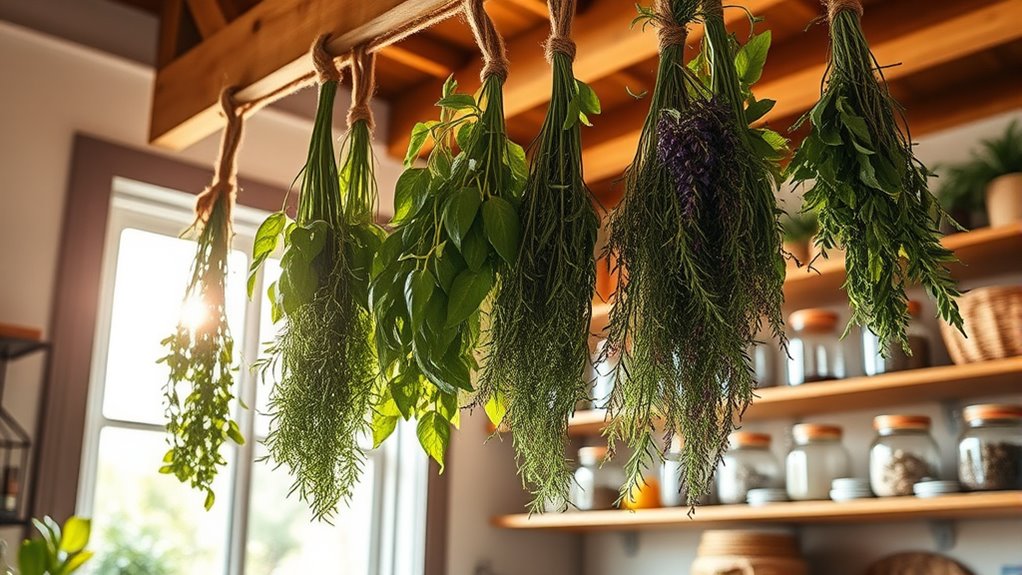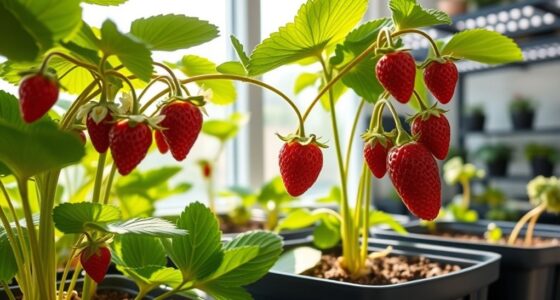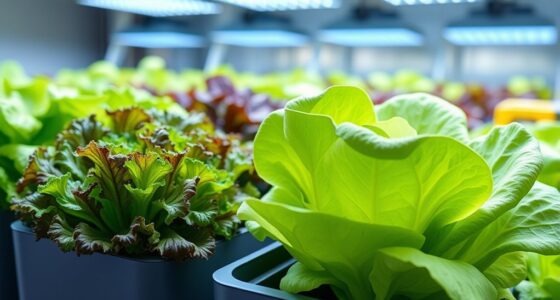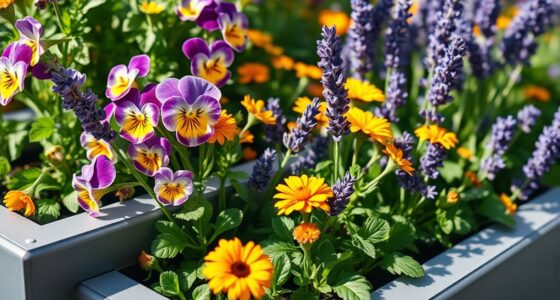To make your herb harvest last, choose healthy, aromatic herbs like rosemary or thyme and harvest them early in the day. Air drying in a dark, well-ventilated space or using a dehydrator works best to preserve flavor and aroma. Store your dried herbs in airtight containers away from light and heat, with labels for easy tracking. Proper techniques and storage help extend their shelf life up to a year—discover more tips to keep your herbs fresh longer.
Key Takeaways
- Harvest herbs early in the day at peak maturity, pruning no more than one-third of the plant for best flavor and aroma.
- Use air drying in a dark, ventilated space or dehydrators to gently dry herbs while preserving their potency.
- Store dried herbs in airtight glass jars or metal containers in a cool, dark, dry environment to maximize shelf life.
- Label storage containers with harvest dates and regularly check for spoilage to maintain freshness and flavor.
- Match dried herbs with complementary foods and incorporate them into seasoning blends to enhance culinary use.
Choosing the Right Herbs for Drying

When choosing herbs to dry indoors, it’s important to select those that retain their flavor and appearance well through the drying process. Some herbs have delicate flavor profiles that diminish easily, so sticking with hardy options ensures aromatic preservation. Herbs like rosemary, thyme, oregano, and sage tend to hold their herb flavor profiles during drying, making them ideal choices. Avoid herbs with tender leaves or high moisture content, as they may lose aroma or become moldy. By selecting robust herbs, you ensure your dried supplies will retain their vibrant aroma and taste, providing fresh flavor even months later. Properly chosen herbs will enhance your cooking and preserve the essence of your garden’s bounty. Additionally, selecting herbs with a high antioxidant content can help maintain their nutritional value during storage.
Methods for Indoor Herb Drying
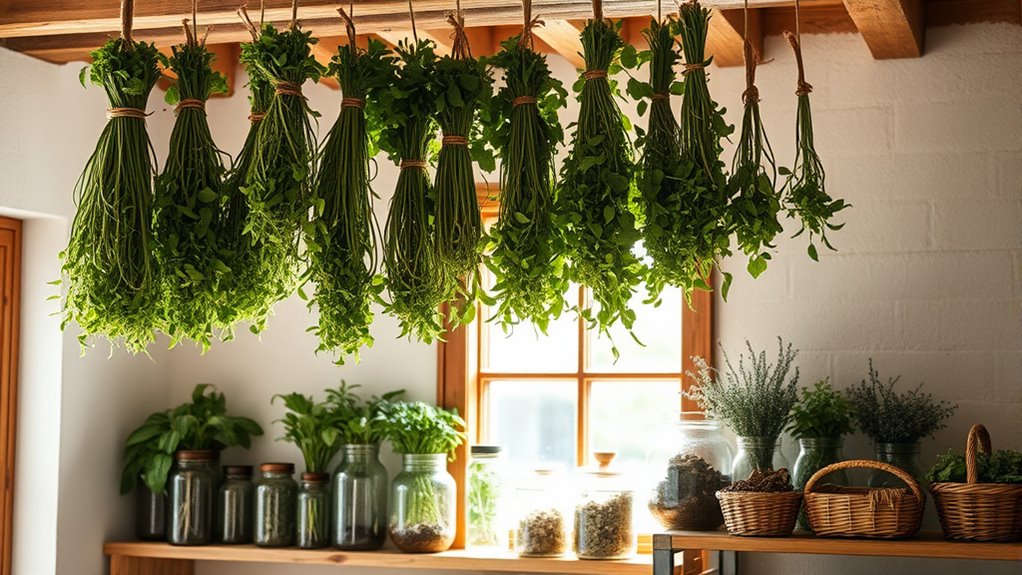
There are several effective methods for drying herbs indoors, each suited to different types and quantities. Your drying environment plays a key role in preserving herb vitality and flavor. Air drying is simple: gather small bunches and hang them upside down in a well-ventilated, dark space to prevent light from degrading essential oils. Using a dehydrator speeds up the process, maintaining herb vitality by controlling temperature and airflow. For herbs with delicate leaves, gentle oven drying on low heat can work, but keep a close eye to avoid overheating. Microwave drying is quick and suitable for small amounts, though it may risk losing some potency. Choose a method that matches your herb type and available space to ensure vibrant, flavorful dried herbs. Herb preservation techniques can also help extend the shelf life of your dried herbs and maintain their aromatic qualities.
Proper Techniques for Harvesting and Preparing Herbs
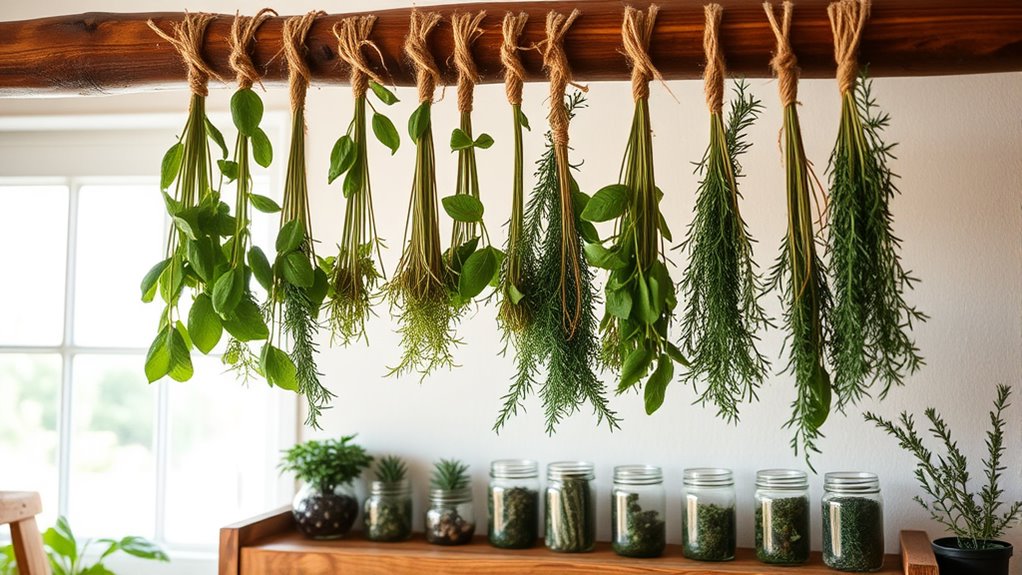
To get the best flavor, you should harvest your herbs at their peak maturity. Handle them gently to avoid bruising and preserve their quality. Using proper cutting techniques guarantees healthy growth and ideal drying results. Cultivating your creative practice can also enhance your ability to experiment and adapt during the harvesting process.
Harvest at Peak Maturity
Harvesting your herbs at their peak maturity guarantees the best flavor, aroma, and potency. To guarantee ideal herb preservation, time your harvest carefully—this is essential for market timing if you plan to sell. Wait until the herbs have developed full color, fragrance, and essential oils, but before they start to bolt or seed. Mature herbs contain the highest concentration of flavor compounds, making them ideal for drying and storage. Keep an eye on the plant’s overall health and growth stage; harvesting too early or too late can diminish quality. Proper timing maximizes herb potency and ensures your preserved herbs retain their fresh qualities longer. By harvesting at the right moment, you set a solid foundation for successful indoor drying and long-term storage. Additionally, understanding the plant’s growth cycle and fetal development can help you choose the optimal time for harvesting, ensuring maximum herb quality.
Gentle Herb Handling
Handling herbs gently during harvest and preparation is essential to preserving their delicate oils, flavors, and aromas. When you handle herbs with care, you prevent bruising and damage that can compromise herb freshness. Always use soft, supportive movements when harvesting, avoiding squeezing or pulling too harshly. Use clean, sharp scissors or pruning shears to make clean cuts, which minimizes stress on the plant. After harvesting, gently shake off excess moisture and avoid unnecessary handling that can bruise the leaves. Proper gentle handling ensures your herbs stay vibrant and flavorful during drying and storage. Additionally, recognizing market manipulation patterns can help you avoid compromised herbs influenced by external factors. By prioritizing herb freshness through careful techniques, you maximize the quality of your herbs and enjoy the full depth of their aromatic qualities in every use.
Proper Cutting Techniques
Using proper cutting techniques is essential to guarantee your herbs stay healthy and flavorful. Begin by selecting the right herbs through careful herb selection—choose lush, disease-free plants with vibrant leaves. When pruning, use sharp scissors or pruning shears to make clean cuts just above a leaf node or set of leaves. This encourages new growth and prevents damage. Always prune early in the day when herbs are most hydrated, and avoid cutting more than one-third of the plant at a time. Proper pruning techniques help maintain the plant’s shape and health, ensuring a continuous harvest. Remember, gentle cuts and thoughtful herb selection are key to preserving the herb’s potency and flavor, making your drying process more successful.
Best Storage Containers and Conditions

Choosing the right storage containers and maintaining ideal conditions are essential to preserving the flavor and potency of your dried herbs. Airtight containers prevent moisture and air exposure, helping herbs stay fresh longer. Store herbs in a cool, dark, and dry place to maintain their aroma and potency. Avoid clear containers that expose herbs to light, which degrades essential oils. Use the following table for ideas:
| Storage Idea | Benefits |
|---|---|
| Airtight glass jars | Preserve aroma, prevent moisture |
| Opaque containers | Protect from light, maintain potency |
| Cool, dark cupboard | Slows degradation, extends shelf life |
| Avoid plastic bags | Reduce static, prevent air exchange |
| Proper labeling | Keep track of herb freshness |
Additionally, maintaining proper storage conditions can significantly extend the shelf life of your herbs.
Tips for Maintaining Flavor and Aroma
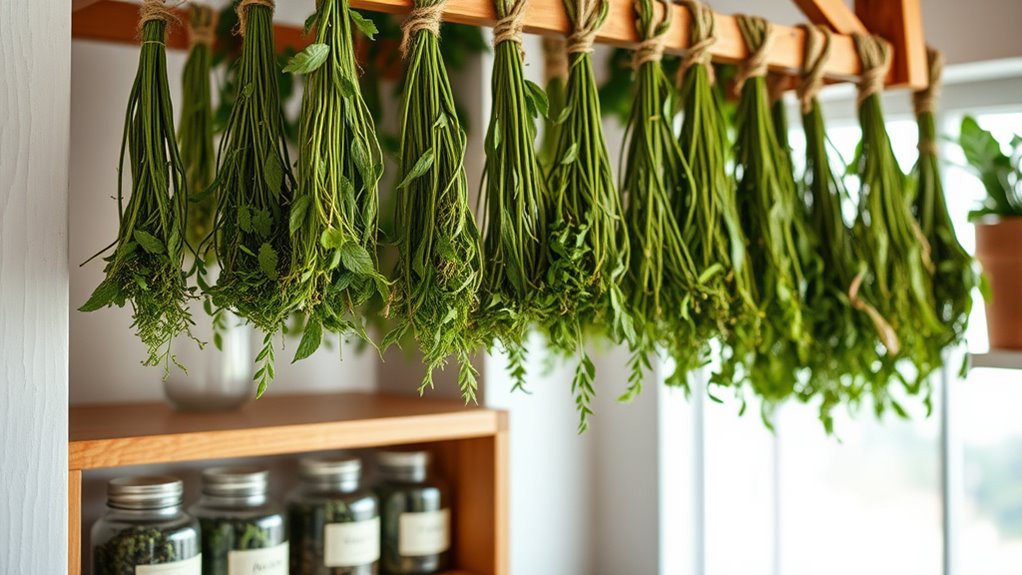
Proper storage conditions play a key role in preserving the flavor and aroma of your dried herbs. To maintain flavor preservation, keep herbs away from direct sunlight, which can degrade their essential oils. Store them in airtight containers to prevent moisture and air from diminishing aroma retention. Choose opaque containers or keep your herbs in a dark cabinet to protect against light exposure. Avoid frequent opening of containers, as this can release volatile compounds that contribute to aroma. Keep your herbs in a cool, consistent temperature environment—ideally between 60-70°F—to prevent flavor loss. Regularly check your storage setup for any signs of moisture or spoilage. Using proper filtration can further ensure that your herbs stay free from airborne pollutants that might affect their quality. By following these tips, you’ll ensure your herbs retain their vibrant flavor and aromatic qualities for months to come.
Using Dried Herbs in Your Culinary Creations

Dried herbs can considerably enhance the flavor of your dishes, even when added in small amounts. To maximize their impact, try herb infusion techniques like simmering herbs in oils or broths, which release concentrated flavors. You can also crumble dried herbs directly into sauces, soups, or stews for a quick flavor boost. When considering culinary pairing ideas, match herbs with complementary ingredients—for example, basil with tomatoes or thyme with roasted vegetables. Dried herbs work well in marinades, rubs, and seasoning blends, adding depth without overpowering. Store your herbs properly to preserve their potency, and experiment with different combinations to discover new flavor profiles. Using dried herbs thoughtfully transforms simple dishes into aromatic, flavorful culinary creations. Additionally, proper storage methods help prevent clutter buildup, ensuring your herbs stay fresh and accessible for future use.
Long-term Storage and Shelf Life of Dried Herbs
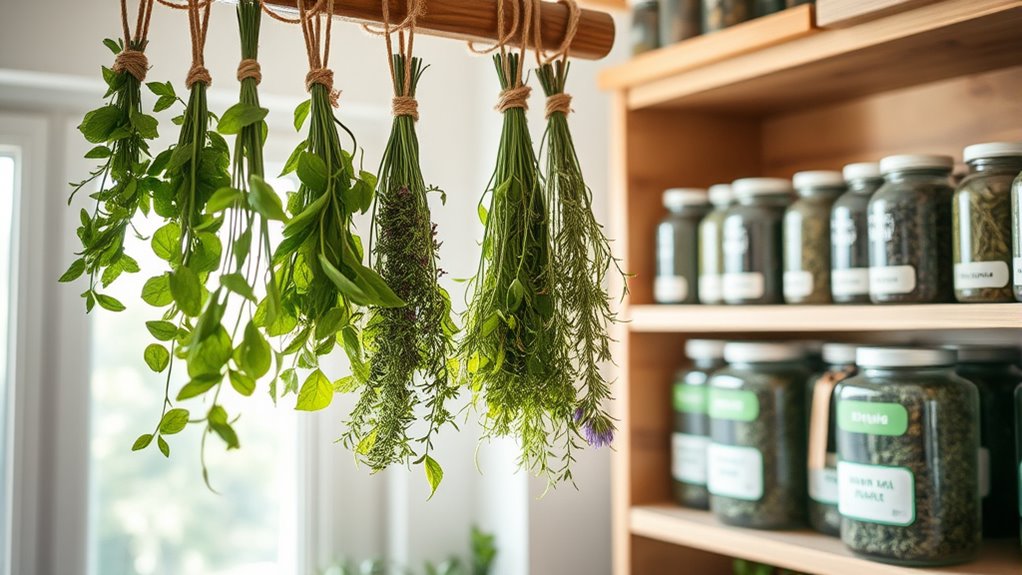
To guarantee your dried herbs maintain their flavor and potency over time, it’s essential to store them correctly. Proper herb preservation directly impacts storage longevity, ensuring your herbs stay fresh and effective longer. Use airtight containers made of glass or metal, and keep them in a cool, dark place away from direct sunlight and humidity. Light and moisture accelerate herb degradation, reducing their shelf life. Label your containers with harvest dates to monitor freshness. Avoid storing herbs near heat sources or in the fridge, which can cause moisture buildup. When stored properly, dried herbs can last up to a year, retaining most of their flavor and aroma. Regularly check your herbs for signs of spoilage, and refresh your stock as needed for ideal herb preservation. Proper storage conditions are crucial for maintaining herb quality over time.
Frequently Asked Questions
How Can I Tell if Herbs Are Fully Dried?
You can tell if herbs are fully dried by checking their herb moisture and aroma retention. When herbs feel brittle and crumble easily between your fingers, they’re likely dry enough. Also, if their aroma is still strong but not overpowering, it indicates proper drying without losing flavor. Avoid herbs that are still moist or limp, as they haven’t dried completely. Fully dried herbs will last longer and retain their essential oils.
Can I Dry Herbs Outdoors if the Weather Is Humid?
Drying herbs outdoors in humid weather is like trying to tame a wild storm—challenging and often futile. Humid weather causes moisture to cling to your herbs, risking mold and spoilage. Outdoor drying in these conditions isn’t ideal; it can turn your precious herbs into a soggy mess. Instead, choose a breezy, dry spot or indoor drying methods to preserve your herbs and keep them flavorful for longer.
Are There Any Herbs That Shouldn’T Be Dried Indoors?
Some herbs shouldn’t be dried indoors, especially delicate ones like basil or mint, which can lose flavor or become moldy if not dried correctly. Also, consider herb toxicity; certain herbs, like rhubarb leaves, are toxic and shouldn’t be dried or stored. For these, outdoor drying might be risky due to humidity or pests. Always research each herb’s specific needs to guarantee safe, effective drying and storage.
What Are Common Mistakes to Avoid When Drying Herbs Indoors?
If you ignore common mistakes, you risk turning your herbs into a crispy, flavorless mess! Don’t overdry herbs or leave them in cramped, stagnant spaces—improper airflow can turn your drying process into a moldy disaster. Keep herbs in a well-ventilated area, check them regularly, and avoid hanging them in direct sunlight. This way, you’ll preserve their aroma and potency, making your harvest last way longer!
How Do I Revive Herbs That Have Lost Their Aroma?
If your herbs have lost their aroma, don’t worry—herb aroma restoration is possible. Try fragrant revival techniques like gently crushing the leaves to release essential oils or rubbing them between your fingers. You can also warm them slightly to boost scent, but avoid overheating. These methods help revive the herb’s natural fragrance, allowing you to enjoy their full flavor and aroma once again.
Conclusion
By mastering indoor herb drying and storage, you’re crafting a treasure chest of flavors to savor year-round. Think of your dried herbs as tiny time capsules, preserving summer’s sunshine and garden’s aroma. With the right techniques, your harvest becomes a lasting symphony of scent and taste, waiting patiently in your kitchen. Keep your herbs well-cared for, and they’ll reward you with vibrant flavor notes that dance on your palate long after the season fades.
